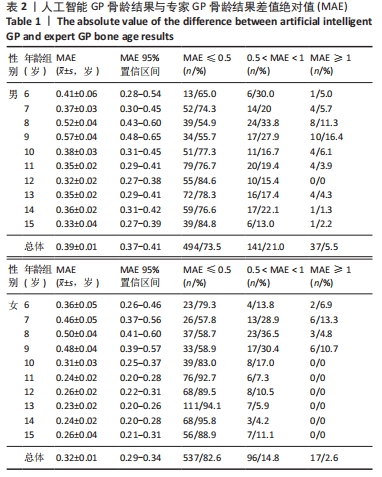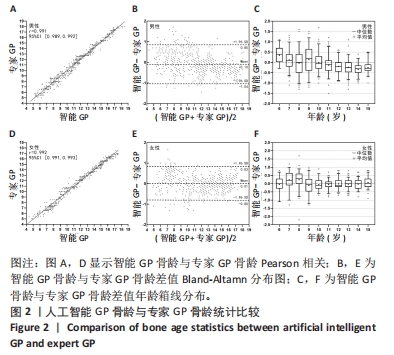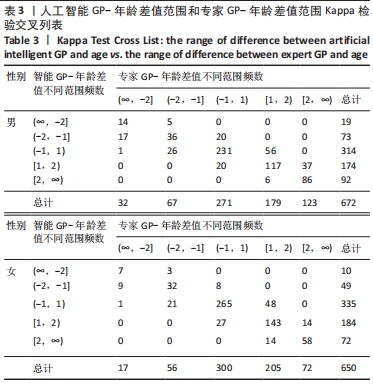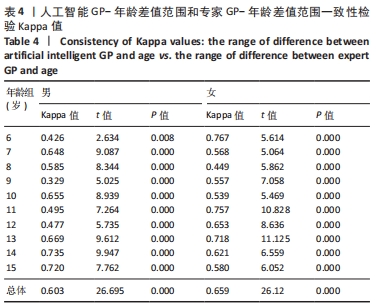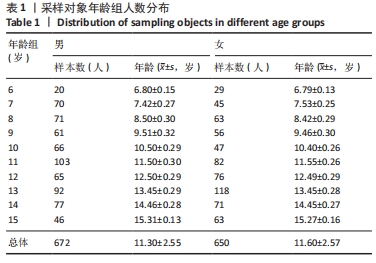中国组织工程研究 ›› 2024, Vol. 28 ›› Issue (28): 4436-4440.doi: 10.12307/2024.466
• 骨组织构建 bone tissue construction • 上一篇 下一篇
人工智能与专家Greulich-Pyle图谱法骨龄评估的一致性比较
李 磊1,潘其乐1,蔡 广1,李志朋1,2
- 1上海体育科学研究所(上海市反兴奋剂中心),上海市 200030;2上海市黄浦区体育事业发展指导中心,上海市 200020
Consistency between artificial intelligence and expert Greulich-Pyle atlas method for bone age assessment
Li Lei1, Pan Qile1, Cai Guang1, Li Zhipeng1, 2
- 1Shanghai Research Institute of Sports Science (Shanghai Anti-doping Agency), Shanghai 200030, China; 2Shanghai Huangpu District Sports Development Guidance Center, Shanghai 200020, China
摘要:

文题释义:
骨龄:是骨骼年龄的简称,需要借助于骨骼在X射线摄像中的特定图像来确定。通常要拍摄人左手手腕部的X射线片,通过X射线片观察左手掌指骨、腕骨及桡尺骨远端的骨化中心的发育程度来确定骨龄。目前在国内医学和体育领域有3种骨龄评估方法较为广泛应用,分别为Greulich-Pyle图谱法(GP法)、CHN计分法(CHN法)、中华05法。Greulich-Pyle图谱法:简称GP法,该方法以其研制者Greulich W.W.和Pyle S.I.两位研究专家命名,图谱有58张标准片,其中男子31张标准片,女子27张标准片,临床医生在评估时把患者左手的骨龄片与标准片进行比较,最相近的标准片的骨龄值为患者的骨龄,如无最相近的标准片,将采用插入法,取2张标准片中间值作为患者骨龄。
背景:人工智能骨龄评估已成为研究热点,国内外研究表明人工智能技术在医学影像领域发展迅速,为更准确快速的对骨龄进行评估提供了可能。
目的:探讨人工智能Greulich-Pyle (智能GP)图谱骨龄评估系统与人工专家Greulich-Pyle(专家GP)图谱评估结果的一致性。方法:骨龄片采样对象为6-15岁儿童青少年,其中男672人,女650人。同一张骨龄片分别用智能GP与专家GP读出骨龄值。智能GP读片结果的准确性采用差值绝对值反映;骨龄结果一致性采用Pearson相关、Bland-Altamn分布图;评估一致性采用Kappa检验。
结果与结论:①智能GP骨龄与专家GP骨龄差值95%置信区间男女总体分别为0.39岁(0.37-0.41岁),0.32岁(0.29-0.34岁),智能GP骨龄与专家GP骨龄差值Bland-Altamn偏差男女分别为(-0.096±0.482)岁,(0.014±0.415)岁;②智能GP骨龄与专家GP骨龄男女相关结果分别为r=0.991,r=0.992,P < 0.000 1;男女所有年龄段差值中位数均在0.5岁之内;Kappa检验值除男子9岁年龄段,其他各年龄段男女均大于0.4,总体Kappa值男女分别为0.603,0.659;③结果表明:在6-15岁儿童青少年范围内,人工智能GP图谱骨龄值与专家评估结果有高度一致性。
https://orcid.org/0009-0009-7115-8589(李磊)
中国组织工程研究杂志出版内容重点:组织构建;骨细胞;软骨细胞;细胞培养;成纤维细胞;血管内皮细胞;骨质疏松;组织工程
中图分类号:
